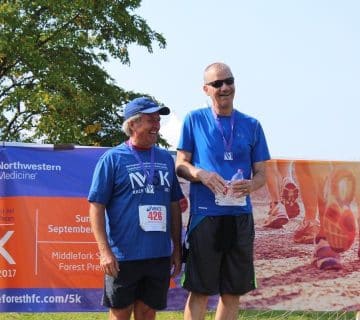Switching his fitness routine to more exercises for Parkinson’s not only helped this former marathon runner improve his balance and gait, he happened to make some new friends in the process.
It’s wintertime in Grayslake, Illinois. Dale Moss, 62, and his wife, Paula, are gearing up to be “snowbirds” for the next couple of months. They’re migrating down to the Southeast for some well-deserved beach time. He decides to squeeze in one more Rock Steady Boxing class before he goes.
Moss has been living with Parkinson’s disease for about 10 years. He’s grown quite fond of the Parkinson’s fitness program held at Northwestern University Medicine Lake Forest Hospital. It’s the same medical institution where he participated in clinical trials and received deep brain stimulation (DBS) surgery three years ago.
DBS is a neurosurgical procedure that implants a neurostimulator (sometimes called a brain pacemaker) that sends electrical impulses to specific targets in the brain to treat Parkinson’s. DBS has become Moss’s passion subject, and he found it “very helpful” particularly at maintaining a loud, strong voice.
“I’m a big fan of all the programs they have at Northwestern, including the DBS surgery I had,” Moss said. “I take a lot of their fitness classes and participate in a monthly support group where I’m able to interact with other Parkinson’s patients and be part of a community.”
A targeted workout routine
Moss learned about the benefits of exercise for Parkinson’s symptoms through Northwestern, and it resonated with the long-time athlete. “Exercise itself is really the only thing that is proven scientifically to slow the progression of Parkinson’s. And it definitely makes symptoms more manageable,” he said.
Before he was diagnosed with Parkinson’s, he was a pickup basketball player; a sub three-hour marathoner who ran races in Chicago, Milwaukee and Boston; and a long-distance swimmer who once swam from Alcatraz Island to San Francisco.
But instead of running up and down a basketball court or jogging for a couple of miles a day, Moss does balance and strength training to improve his balance and gait. “I’m not always as steady as I want to be,” he said.
“These days I’m more focused on exercises that target Parkinson’s rather than doing some of those more grandiose events I used to do in the past. That’s the direction I’m going now athletically. I know that I need to be working out every day.
“I do a lot of stuff like squats, lunges, abduction-type exercises where you might balance on one foot while doing curls. These are the types of exercises that will help improve my quality of life and make it easier to do things like get up out of chairs.”
The power of community
At first, Moss wasn’t sure if he would enjoy working out with others living with Parkinson’s disease.
“I’ll be honest. There was a time when I didn’t want to see what other Parkinson’s patients looked like,” he admitted. “But then eventually I got over myself and realized how helpful it really is. There is so much to be learned from being around other Parkinson’s patients. It almost feels like a tough love sort of thing where we’re all in this together and we can get through it.”
“The interesting thing is that this disease manifests itself differently in everybody,” Moss continued. “You may have similar motor symptoms, but it’s still a little different, especially some of the non-motor symptoms that are more invisible. You find yourself sharing your experiences with other folks and learning so much from them.”
In fact, Moss had gotten so accustomed to working out with his buddies at the Rock Steady Boxing class, he realized he was going to miss them during the two months he’d be “snow birding” with his wife.
“Everybody in my boxing class knew I was leaving for a couple of months. ‘What are you going to be doing?’ they asked. I said, ‘The same exercises I’ve been doing here but with the added benefit of enjoying long walks on the beach with my wife,’” he recounted with a laugh.
“But I’ll miss that comradery during the two months I’ll be away. There’s a social aspect to it that I really enjoy. In fact, I find it more motivating to work out with other Parkinson’s patients than working out with a physical therapist or personal trainer.”



